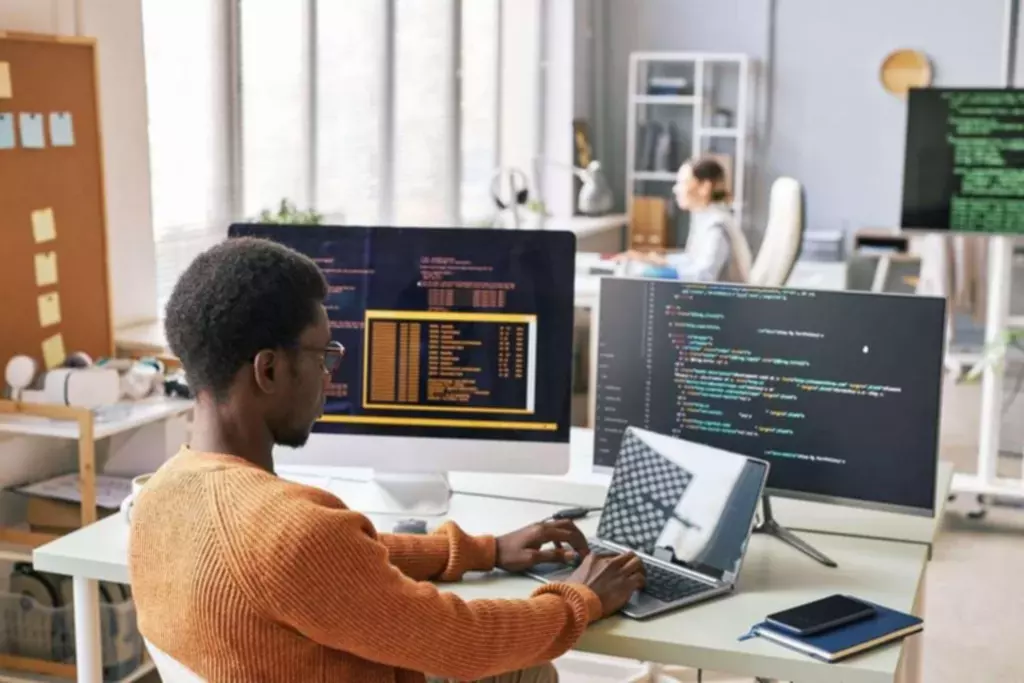Instead, the hardware is now so small that it can even match into sensible spatial computing glasses. Humans are naturally spatial beings that understand and interact with the world volumetrically, so spatial computing guarantees to return us to spatial thinking that may be very usually misplaced as we age and when we are pressured to translate our creativity into flat surfaces. Its promise is to make us more productive, environment friendly, inventive and facilitate communication with others. Spatial computing can finally lead to making better decisions, whether in business or in other aspects of our lives. Smaller internet of things units, like a robotic floor cleaner, would be unlikely to be known as a spatial computing gadget because it lacks the more advanced human-computer interactions described above. Spatial computing mirrors how we work together with digital objects in the actual world.
Since 2017 Apple has been enhancing AR Kit and working on the Vision Pro hardware. At the same time, they had been creating a brand new OS for this gadget and a software development software, VisionOS SDK, to develop apps and companies on their new headset. Broadly, a future the place an organization can management every thing you see, hear and work together with via its headsets may require new laws about how the expertise is used.
Enabling The Spatial Computing Revolution
If you are in the us and have an additional $3,500 lying around, you can now get Apple’s latest gadget, the Vision Pro — but don’t name it a virtual actuality headset. To integrate digital photographs into the actual world, spatial computing employs a mixture of the following features which offer a realistic experience. VERSES has developed its COSM operating system that integrates the varied flows of knowledge and analytics from the elements of spatial computing elements.
Will we be hearing a lot more about spatial computing and combined reality from the companies keynoting and exhibiting at some of tech world’s greatest events? My hunch is that we are going to and that we’re about to hear much more about what they are doing in this area. While spatial computing and edge computing sound related, they refer to totally different basic ideas.
The History Of Spatial Computing
Our physical distance from another particular person, our body’s relationship to gravity, and commuting a well-recognized route are only a few examples of this always-online system. Although, spatial computing corporations are concerned in much more than AR, VR or the deployment of spatial computing glasses, beginning with the concept of augmented reality makes it easier to understand what spatial computing is all about. This is as a end result of AR illustrates the possibilities provided by linking the actual and the digital world. Spatial computing examples include AR glasses, like Meta’s Ray-Ban sensible glasses and Xreal’s Air 2 Ultra; and VR headsets, like the Meta Quest three and Apple Vision Pro.
- Games like Pokémon Go and its predecessor, Ingress, use GPS and augmented actuality know-how to create gaming experiences which are particular to the user’s location and incorporate aspects of the encompassing surroundings.
- The age of AI hardware, smartglasses, and spatial computing is right here – and you’ll assist shape that future today.
- It includes augmented actuality, blended reality and virtual reality recreations of real-world places.
- It takes under consideration the position, orientation, and context of the wearer, in addition to the objects and surfaces around it.
- The GPS in a automotive, a virtual residence assistant with speech recognition capabilities, and QR code scanners are all examples of spatial expertise.
It consists of elements of what some call ambient computing, ubiquitous computing and combined reality, however it is not restricted to just this. He writes about disruptive tech developments including synthetic intelligence, digital and augmented reality, blockchain, Internet of Things, and cybersecurity. The greatest spatial-computing units cost hundreds of dollars and aren’t accessible to everybody. That’s why they have yet to make their dent within the consumer space and have found restricted success in area of interest enterprise functions where the increase in productiveness justifies the cost.
As an evolving form of computing, spatial computing has many parts that interconnect and are available together to make spatial computing work. Here are some examples of hardware, software program, data/information and connectivity that form a half of spatial computing. Just like cell or personal computing isn’t outlined by only one know-how or one single piece of hardware, so too, spatial computing can’t be boiled right down to just one single factor. If you have an interest in studying about examples of virtual actuality and spatial computing, don’t hesitate to visit our website for more information.
Spatial computing describes digital experiences that incorporate real-world places and objects, typically taking the form of augmented actuality, mixed reality or digital reality that references real-world locations. Spatial Computing permits us to navigate the world alongside robots, drones, vehicles, digital assistants, and past. It is a mixture of software program, hardware and knowledge that enables people and technology to connect in new methods, ushering in a brand new type of computing that could be even more impactful than personal computing and cellular computing have been on society. Spatial computing creates immersive gaming and leisure experiences that let you work together with virtual objects and characters in a pure and intuitive way. For instance, instead of a keyboard or joystick, you would use hand gestures or your gaze to regulate avatars and manipulate objects in a sport.
How Does Spatial Computing Work?
However, regardless of this, many of us have yet to be taught what spatial computing is or the means it works. Even because the landscape continues to grow, with the arrival of digital twins, the metaverse, IoT, and XR, confusion abounds for so much of customers. Think of “spatial computing” as an umbrella term that refers to merging the digital world with the bodily world in a seamless method.

VR, on the opposite hand, creates a completely immersive digital environment that replaces the person’s physical environment. The expectation that the pictures, sounds, and accelerations processed by a device are contributing to the real-time perceptions of an individual human, spatial computing blends digital experiences into a user’s expertise of the bodily world. To allow a person to deal with any flat surface in the quick setting https://www.globalcloudteam.com/ as a touchscreen or show is merely the obvious extension of the present paradigm of UI in mobile computing to spatial computing. Volumetric rendering, holographic processing, and sensor fusion will enable interfaces to knowledge and applications that we can’t yet think about. Zuckerberg additionally spoke about ushering the subsequent computing platform through advancements in sensible glasses.
The type factor nonetheless stays to be seen and we will see lots of new hardware and transitional tools on the method in which to devices that combine compute, communications and comfort in the next decade. When we converse of spatial computing, we are speaking concerning the next wave of computing, which comes after private computing and cell computing. Boiling it down to 1 single know-how could be like boiling down cell computing to one single know-how. In easy terms, spatial computing leverages expertise to merge computing into our everyday world.
Augmented And Digital Actuality 2Zero: Why Spatial Computing Is Extra Than Simply Ar And Vr
Although the term “spatial computing” has been around for decades, it gained traction following the 2023 announcement of the Apple Vision Pro, a headset with AR, VR and blended reality capabilities that Apple describes as its first spatial laptop. Interestingly, the concept of constructing the pc or the hardware you use to interact with digital info more accessible and transparent was at the coronary heart of Steve Jobs’ aim of constructing the PC easier to use. Thus, he gave us new user interfaces like the Mac GUI, iPod wheel, iPod Touch, iPhone and now, with the Vision Pro, Apple introduces gestures, eye monitoring, voice commands, and prompts. Spatial computing, such as pure language processing or deep neural networks, is a technological concept whose workings and implications may be difficult to know. However, at its core, spatial computing defines how we as humans interact with our surroundings. This means, that the human brain naturally processes and integrates info from our immediate surroundings by way of spatial relationships.
The MR system and its operating system are outlined as “spatial computing” solutions. But he believes we could additionally be approaching an inflection point because of a variety of recent technological developments. For one, pixel density is essential for any device that’s held up close or worn as a headset, as lower resolutions improve eye pressure and break immersion. This is spatial computing in broad terms — a system for computers to work together and perceive the bodily surroundings around customers, and the place they will also work together with virtual objects. The significant change here is that spatial computing expands computing past simply cellular units, making nearly any flat floor an interface with software program. On the other hand, Spatial Computing is a broader concept that underlies and offers which means to the mix of a number of applied sciences, including Augmented Reality (AR) and Mixed Reality (XR).
Every day, hundreds of thousands of individuals all around the globe use spatial computing apps –whether it’s GPS, the speech recognition of a digital residence assistant, or the QR codes that we scan with our smartphone cameras. Despite this, many of us still have no idea what spatial computing is or the method it works. It is a scale expertise that gets its “eyes and ears” from AI and Computer Vision and ushers within the era of Large Vision Models (LVM).

Thanks to the rise of recent protocols for Web three.0 (the spatial web), XR innovations, and the metaverse, spatial computing is in all places. Without spatial know-how, a digital reality environment can Spatial Computing be one thing you can see and walk round, however by no means contact or interact with. You might see a virtual book on a table, but reaching out wouldn’t allow you to flip through the pages.
Defining Spatial Computing
Humans translate the two-dimensional images that they see right into a 3D model of the world, make sense of objects on the earth and then direct their hands to act. For instance, when we pour a cup of tea, we watch the cup as we pour, determine when the cup is full and then stop pouring. It’s an rising area and the realm where we’ll see future computing advances.


